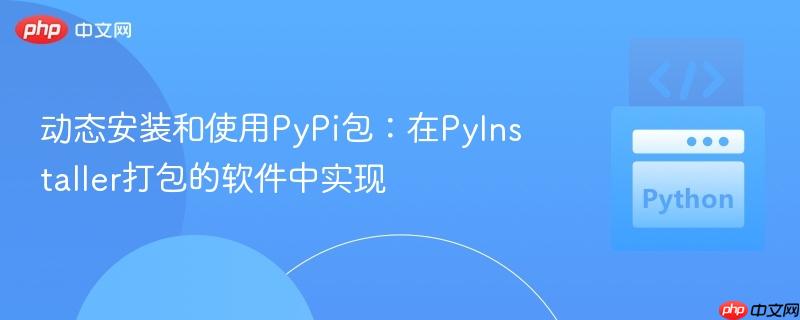
在PyInstaller打包的Python软件中,动态安装和使用PyPi包是一个常见的需求,特别是在需要根据用户自定义函数或配置来扩展软件功能时。本文将介绍如何在PyInstaller打包的软件中,动态地从PyPi安装并使用第三方库。
pip 本身就是一个 Python 模块,可以直接在代码中导入并使用。这种方法简单直接,可以方便地控制包的安装、卸载和列表。
import pip
try:
pip.main(['install', 'some_module'])
# 或者指定安装路径:
# pip.main(['install', '--target=/path/to/internal', 'some_module'])
except Exception as e:
print(f"安装失败: {e}")
# 列出已安装的包
pip.main(['list'])
# 冻结已安装的包,生成 requirements.txt 格式的列表
pip.main(['freeze'])
# 卸载包
pip.main(['uninstall', 'some_module'])注意事项:
另一种方法是使用 subprocess 模块调用 python -m pip 命令。这种方法更通用,也更不容易受到 pip 版本的影响。
import subprocess
import sys
try:
subprocess.run([sys.executable, '-m', 'pip', 'install', 'some_module'], check=True)
# 或者指定安装路径:
# subprocess.run([sys.executable, '-m', 'pip', 'install', '--target=/path/to/internal', 'some_module'], check=True)
except subprocess.CalledProcessError as e:
print(f"安装失败: {e}")
# 列出已安装的包
subprocess.run([sys.executable, '-m', 'pip', 'list'])
# 冻结已安装的包,生成 requirements.txt 格式的列表
subprocess.run([sys.executable, '-m', 'pip', 'freeze'])
# 卸载包
subprocess.run([sys.executable, '-m', 'pip', 'uninstall', 'some_module'])注意事项:
假设用户上传了一个 Python 文件,其中使用了 requests 库,而该库在初始打包时并未包含。我们可以先动态安装 requests,然后再执行用户上传的代码。
import subprocess
import sys
import importlib.util
import os
def install_and_run_user_code(user_code_path):
try:
# 动态安装 requests
subprocess.run([sys.executable, '-m', 'pip', 'install', 'requests'], check=True, capture_output=True, text=True)
print("requests 安装成功")
# 加载用户代码
spec = importlib.util.spec_from_file_location("user_module", user_code_path)
user_module = importlib.util.module_from_spec(spec)
spec.loader.exec_module(user_module)
# 调用用户代码中的函数 (假设用户代码中有一个名为 'main_function' 的函数)
user_module.main_function()
except subprocess.CalledProcessError as e:
print(f"安装 requests 失败: {e.stderr}")
except Exception as e:
print(f"执行用户代码失败: {e}")
# 示例用户代码文件
user_code = """
import requests
def main_function():
try:
response = requests.get("https://www.example.com")
print(f"请求成功: {response.status_code}")
except Exception as e:
print(f"请求失败: {e}")
"""
# 创建临时用户代码文件
with open("user_code.py", "w") as f:
f.write(user_code)
# 调用函数
install_and_run_user_code("user_code.py")
# 清理临时文件
os.remove("user_code.py")总结:
通过以上方法,可以在PyInstaller打包的软件中实现动态安装和使用PyPi包,从而扩展软件的功能,满足用户自定义的需求。选择哪种方法取决于具体的需求和环境。subprocess 方法通常更可靠,但需要注意错误处理和安全性。使用 pip 模块则更加简洁,但可能存在兼容性问题。务必在实际环境中进行充分测试,以确保程序的稳定性和可靠性。
以上就是动态安装和使用PyPi包:在PyInstaller打包的软件中实现的详细内容,更多请关注php中文网其它相关文章!

每个人都需要一台速度更快、更稳定的 PC。随着时间的推移,垃圾文件、旧注册表数据和不必要的后台进程会占用资源并降低性能。幸运的是,许多工具可以让 Windows 保持平稳运行。

Copyright 2014-2025 https://www.php.cn/ All Rights Reserved | php.cn | 湘ICP备2023035733号